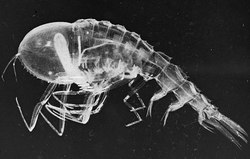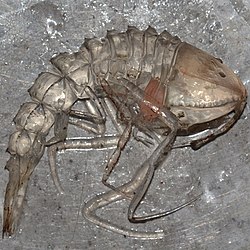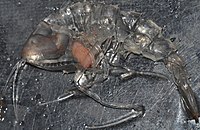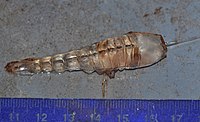Biology:Cystisoma
| Cystisoma | |
|---|---|

| |
| Photograph of Cystisoma in lateral view | |

| |
| Caught specimen collected in Hawaii | |
| Scientific classification | |
| Domain: | Eukaryota |
| Kingdom: | Animalia |
| Phylum: | Arthropoda |
| Class: | Malacostraca |
| Superorder: | Peracarida |
| Order: | Amphipoda |
| Suborder: | Hyperiidea |
| Family: | Cystisomatidae Willemöes-Suhm, 1875 |
| Genus: | Cystisoma Guérin-Méneville, 1842 |
| Synonyms | |
| |
Cystisoma is a genus of amphipod. It is the only member of the family Cystisomatidae within the Hyperiidea.[1][2][3][4][5] The genus is noted for its nearly completely transparent body, adapted for life in low light waters.
Description
Gallery
Cystisoma are characterized by unpigmented, transparent bodies which render them essentially invisible in water unless under precisely angled lighting.[6] Only their eyes are pigmented. There is only a single pair of eyes which are large and directed upwards, being spread into a thin sheet on the upper surface of the head. This is likely an adaption of life in the ocean depths, where the only major light source is from above.[7][8]
Marine biologists at Duke University and the Smithsonian analyzed the crustacean's shell and discovered that it was covered in microscopic spheres that significantly reduce reflected light, thus giving the organism an antireflective coating. The spheres are believed to be bacteria due to their morphology and method of reproduction. Minute structures called nanoprotuberances were also observed on the Cystisoma's body, notably on the organism's legs. Researchers believe that they act as a buffer between light and the amphipod's body, significantly reducing surface reflection.[9][6]
Size
Cystisoma are the largest of hyperiids, reaching lengths over 100 mm.[9]
Distribution
Cystisoma inhabit the dim epipelagic and mesopelagic zones. They can be found in all of the world's oceans.[citation needed] They appear to be freely swimming organisms and unlike other hyperiids, do not appear to be closely associated with salps.[9]
Species
- Cystisoma fabricii Stebbing, 1888
- Cystisoma gershwinae Zeidler, 2003
- Cystisoma latipes (Stephensen, 1918)
- Cystisoma longipes (Bovallius, 1886)
- Cystisoma magna (Woltereck, 1903)
- Cystisoma pellucida (Willemöes-Suhm, 1873)
References
- ↑ "Cystisoma Guérin-Méneville, 1842". WoRMS - World Register of Marine Species. https://www.marinespecies.org/aphia.php?p=taxdetails&id=101793.
- ↑ "Cystisoma". Encyclopedia of Life. https://eol.org/pages/46521845. Retrieved 2022-01-14.
- ↑ "Cystisoma". Integrated Taxonomic Information System (ITIS). US Federal Government. https://www.itis.gov/servlet/SingleRpt/SingleRpt?search_topic=TSN&search_value=95367#null.
- ↑ Hyperiid amphipods (Amphipoda, Hyperiidea) of the world oceans. Smithsonian Institution Libraries and National Science Foundation. 1992. OCLC 489185653. http://worldcat.org/oclc/489185653.
- ↑ "A review of the hyperiidean amphipod family Cystisomatidae Willemöes-Suhm, 1875 (Crustacea: Amphipoda: Hyperiidea)". Zootaxa 141 (1): 43. 2003-01-31. doi:10.11646/zootaxa.141.1. ISSN 1175-5334.
- ↑ 6.0 6.1 "Camouflage: Being Invisible in the Open Ocean". Current Biology 26 (22): R1179–R1181. November 2016. doi:10.1016/j.cub.2016.09.056. PMID 27875694.
- ↑ "Strange eyes, stranger brains: exceptional diversity of optic lobe organization in midwater crustaceans". Proceedings. Biological Sciences 288 (1948): 20210216. April 2021. doi:10.1098/rspb.2021.0216. PMID 33823669.
- ↑ Land, M. F. (1989). "The eyes of hyperiid amphipods: relations of optical structure to depth" (in en). Journal of Comparative Physiology A 164 (6): 751–762. doi:10.1007/BF00616747. ISSN 0340-7594. http://link.springer.com/10.1007/BF00616747.
- ↑ 9.0 9.1 9.2 "Nanostructures and Monolayers of Spheres Reduce Surface Reflections in Hyperiid Amphipods" (in English). Current Biology 26 (22): 3071–3076. November 2016. doi:10.1016/j.cub.2016.09.033. PMID 28094029.
External links
Wikidata ☰ Q10465209 entry




